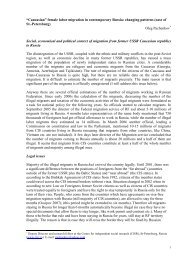THORIUM AS AN ENERGY SOURCE - Opportunities for Norway ...
THORIUM AS AN ENERGY SOURCE - Opportunities for Norway ...
THORIUM AS AN ENERGY SOURCE - Opportunities for Norway ...
You also want an ePaper? Increase the reach of your titles
YUMPU automatically turns print PDFs into web optimized ePapers that Google loves.
6. THE BACK END OF THE <strong>THORIUM</strong> FUEL CYCLE<br />
The Back End of the Thorium Fuel Cycle<br />
The back end of the thorium fuel cycle consists of fuel reprocessing and waste storage. It differs<br />
from the back end of a uranium cycle in some important aspects:<br />
• Virtually no plutonium or other transuranic elements are produced.<br />
• The waste products are free from the long-lived alpha-emitters.<br />
• Due to the stability of thorium dioxide, more aggressive chemicals must be used in the process,<br />
thus increasing the corrosion problems in the reprocessing plant.<br />
6.1 Thorium Cycle in Reactors<br />
Breeding of U-233 in thermal reactors is difficult and requires excellent neutron economy and online<br />
fuelling-reprocessing. Breeding of U-233 in fast reactors is possible, but the doubling time of<br />
the fissile inventory is much higher (about 250 years) than in the case of Pu-239 breeding.<br />
The reactor must be started with U-235 or Pu-239 (topping fuel), or with an accelerator-driven<br />
neutron generator. After a number of years, sufficient U-233 is <strong>for</strong>med to obtain equilibrium<br />
without further addition of topping fuel.<br />
At present, the best thermal reactors <strong>for</strong> the thorium cycle are the Molten Salt Reactor (MSR),<br />
the Heavy Water Reactor (HWR, or C<strong>AN</strong>DU) and the High Temperature Reactor (HTR). Thorium<br />
could also be used in Light Water Reactors (LWRs). Thorium can be used without any topping in<br />
conventional fast reactors.<br />
6.1.1 Once-Through (Open) Thorium Cycle<br />
In the case of the once-through cycle (open cycle) in LWRs, there is always a need <strong>for</strong> topping fuel.<br />
Maximum benefit from the produced U-233 requires as high as possible burnup, and U-233 is the<br />
best topping fuel <strong>for</strong> minimum actinide production. The introduction of thorium reduces the<br />
average annual consumption of uranium only by a few percent [135]. The radiotoxicity due to the<br />
actinides in the spent fuel is significantly reduced compared with that of spent UO2 fuel. After 10<br />
000 to 30 000 years of storage, the remaining U-233 dominates the radiotoxicity. However, in this<br />
last period of geological storage the actinides <strong>for</strong>m only a minor risk, as fission products dominate<br />
the dose due to dispersion.<br />
Reactors with higher fertile-to-fissile conversion ratios can benefit more from thorium fuelling. An<br />
example of what can be achieved with the once-through cycle in a C<strong>AN</strong>DU heavy-water reactor is<br />
reported by the Energy Research Centre of the Netherlands (ECN) [136], [137]. In Figure 6.1 the<br />
curve labelled “A” represents the effect of using thorium with HEU topping. The thorium-cycle<br />
waste results in a relatively low waste toxicity immediately after the fission product period (up to<br />
about 600 years) because less plutonium and americium are <strong>for</strong>med. Later, the radiotoxicity<br />
becomes as high as that of unreprocessed LWR spent fuel because of Ra-226 from U-234.<br />
However, higher burnup could further reduce the radiotoxicity. In practice other topping fuels can<br />
be used (such as MEU), <strong>for</strong> economic reasons or to fulfil non-proliferation requirements, but this,<br />
un<strong>for</strong>tunately, leads to additional radiotoxicity contributions.<br />
Similar results are obtained in the HTR, since it has the same conversion ratio and uses similar<br />
annual quantities of thorium and natural uranium fuel as the LWR. In a fast reactor, the open<br />
71

















